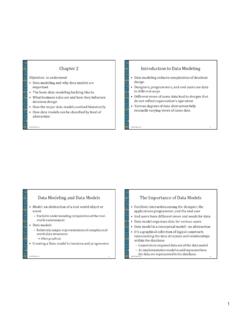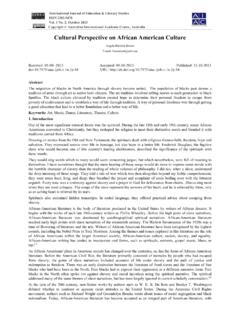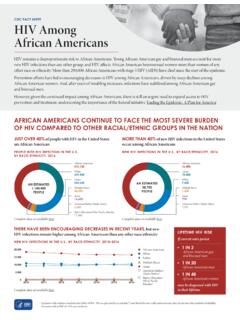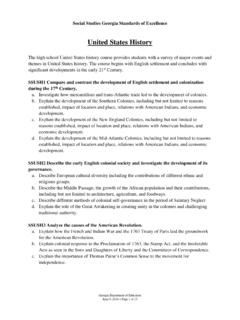Transcription of African Americans in the Revolutionary War
1 10/17/2016 African Americans in the Revolutionary War | The Gilder Lehrman Institute of american by era/war for independence/essays/ African Americans Revolutionary war1/5 Detail of Crispus Attucks' death from"The Bloody Massacre" by PaulRevere, 1770. (Gilder LehrmanCollection) African american SOLDIERSA frican Americans in theRevolutionary Warby Michael Lee LanningFrom the first shots of the american Revolutionary War until the ultimatevictory at Yorktown, black men significantly contributed to securingindependence for the united states from Great Britain. On March 5,1770, Crispus Attucks, an escaped slave, was at the center of whatbecame known as the Boston Massacre that fanned the flames ofrevolution.
2 Once the rebellion began, Prince Estabrook, another AfricanAmerican, was one of the first to fall on Lexington Green inMassachusetts on April 19, 1775. Other black men fought to defendnearby Concord Bridge later in the least a dozen black men fought at the Battle of Bunker and BreedsHill the following June 17. Cuff Whittenmore was cited for fightingbravely and allowed to keep a sword he captured from a British black soldier, Peter Salem, a veteran of the Battle of ConcordBridge, killed yet another senior British officer in the fight. Later, fourteen american officers signed adocument recognizing Salem Poor for being a brave and gallant soldier.
3 In the famous painting of thebattle by John Trumbull, two African Americans are included in the scene."The Death of General Warren at the Battle of Bunker's Hill, June 17, 1775" by JohnTrumbull, post 1815. (Museum of Fine Arts, Boston)From the time of the arrival of the first black slaves to the american colonies in 1619, they werewelcomed into the ranks of local militias to counter the threat from Native Americans . This practiceremained, especially in the northern colonies, for more than a century and a half, only changing whenGeneral George Washington, a Virginia slave owner, took command of the newly formed Continental10/17/2016 African Americans in the Revolutionary War | The Gilder Lehrman Institute of american by era/war for independence/essays/ African Americans Revolutionary war2/5 Army near Boston on July 3, 1775.
4 Washington and his fellow rebels saw no need for the enlistment ofblacks, slave or free. A few may have seen the irony in enlisting slaves to fight for freedom. Some slaveowners did not want to risk their valuable property in combat or perhaps have slaves freed for others, especially in the South, where blacks outnumbered whites, feared the potentialconsequences of arming African Americans . Massachusetts took first action, issuing a resolution thatproclaimed, no slaves be permitted into this army upon any consideration whatsoever. On July 10, Washington posted an order directing, You are not to enlist any stroller, negro, orvagabond.
5 Washington and other officials did not want blacks in their ranks, and did not see theRevolution as a vehicle to end slavery even though they were seeking independence for the Declaration of Independence began with all men are created equal, there is no evidence thatits author, Thomas Jefferson, or any of its signers had any intention of ending slavery in , a slave owner, did include a clause condemning the British King George III for interfering withcolonial law prohibiting the future importation of slaves, but even that was deleted in the final draft afteropposition from representatives from Georgia and South Washington made efforts to keep blacks out of his ranks, the British were not reluctant to havethem.
6 Seeking to exploit american prejudices and to bolster their own ranks that were operating far fromhome, many British commanders welcomed escaped slaves into their camps. On November 7, 1775,John Murray, the Earl of Dunmore and the Royal Governor of the colony of Virginia, issued aproclamation that read, I do hereby declare all indentured servants, Negroes or others free, that areable and willing to bear arms, they joining His Majesty s troops, as soon as you may be, for the morespeedily reducing this Colony to proper dignity. Slaves immediately began to risk the dangers of flightfrom bondage with a yearning for freedom.
7 Within a month, Lord Dunmore organized more than 300escaped slaves into what he called his Ethiopian Regiment, complete with uniforms emblazoned withthe slogan Liberty to Slaves. Over the next five months, more than 30,000 former slaves rallied to Dunmore s promise of , like the Ethiopian Regiment, took up places in the front lines, while others worked in the rear aswagon masters, cooks, and laborers. Others assumed more unusual jobs. Bill Richmond, described as a man of color, served as the hangman when the rebel spy Nathan Hale was executed in New York Cityin that many slaves were joining the British and facing personnel shortages of his own, Washingtonreconsidered his policy of exclusion.
8 On December 30, 1775, he issued orders allowing the enlistment offree blacks but continued his ban on the recruitment of slaves. Washington s subordinates welcomed thispolicy and many went so far as to ignore the second part and enlist black soldiers with no concern fortheir status of free or slave. Setbacks on the battlefield in 1776 forced the rebels to take even further action. When the members ofthe Continental Congress asked the states in September to provide an additional eighty eight battalionsto reinforce the army and another sixteen battalions three months later, they suggested that the statescould fill their quotas by draft, from their militias, or in any other way.
9 Field commanders interpreted the in any other way as an authorization to recruit African Americans . The mid Atlantic and northern statesbegan to accept blacks, slave and free, into integrated ranks. The southern states remained reluctant toarm and serve with black soldiers but did recruit them for support roles. All blacks were promisedfreedom for their service and their owners were promised compensation for the loss of their the remainder of the war, blacks served alongside whites while in pursuit of liberty andindependence. In the 1851 painting Washington Crossing the Delaware, artist Emanuel Leutze shows a10/17/2016 African Americans in the Revolutionary War | The Gilder Lehrman Institute of american by era/war for independence/essays/ African Americans Revolutionary war3/5black soldier at Washington s side in their boat as they crossed the river to earn a much needed victoryat Trenton, New Jersey, on December 26, 1776.
10 "Washington Crossing the Delaware" by Emanuel Leutze, 1851. (MetropolitanMuseum of Art)The British recognized the presence and effectiveness of the black soldiers in the Continental Army. OnOctober 23, 1777, a Hessian officer wrote of his rebel opponents saying, No regiment is to be seen inwhich there are not Negroes, in abundance, and among them are able bodied, strong, brave fellows. African Americans contributed to the Revolution in the Navy as well. Because of the hazards of the sea,fishing and merchant vessels were always short of crewmen and did not pay any attention to the color ofa sailor s skin if he was willing to serve.













